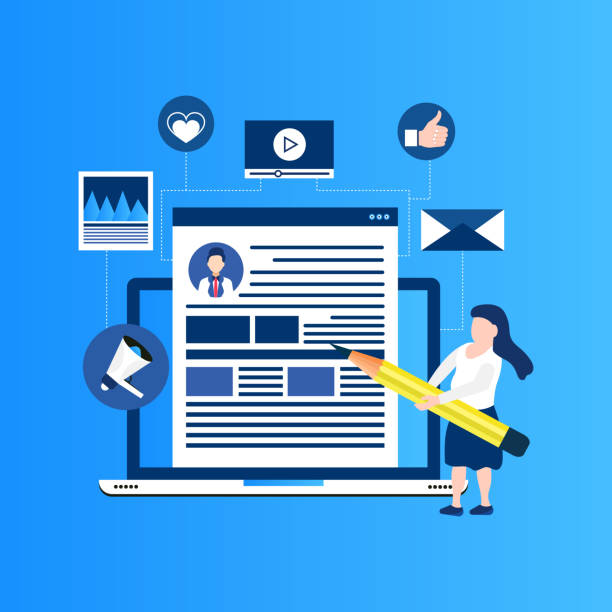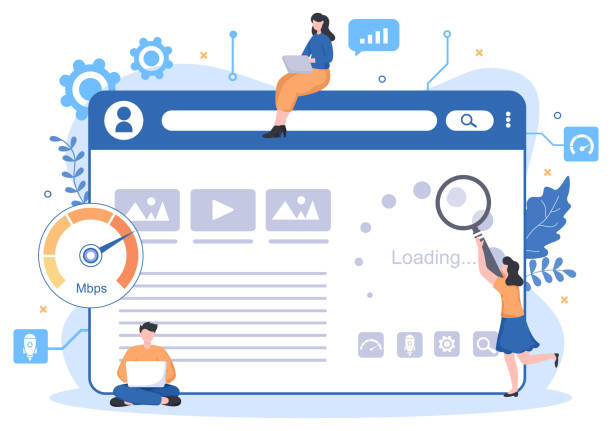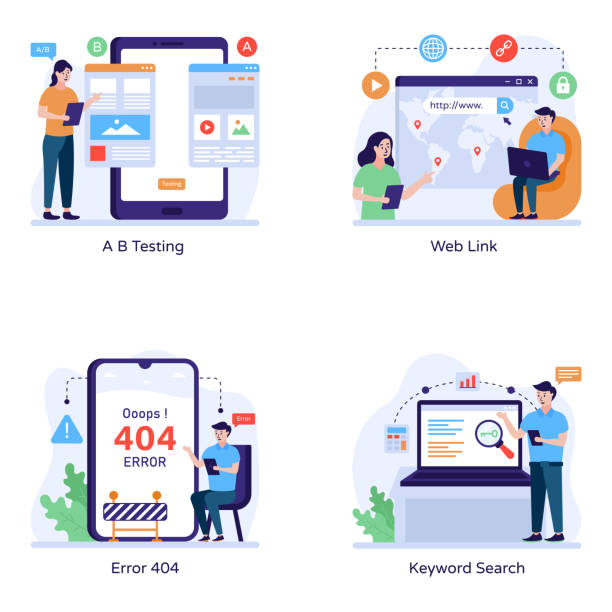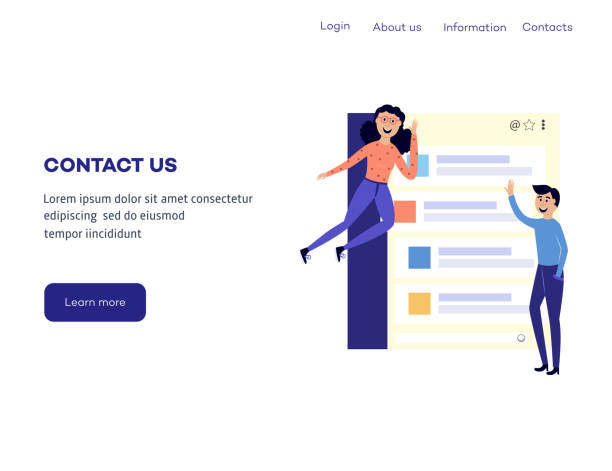The Importance of Fast Website Design in Today’s World

In the current digital age, website speed is not just a competitive advantage, but has become an absolute necessity.
#Fast_Website_Design is no longer a luxury option, but a vital factor for the success of any online business.
Numerous studies have shown that users expect a website to load in less than three seconds, and if not, many of them leave the page.
This means losing potential visitors and, consequently, reducing sales and engagement opportunities.
From the perspective of Search Engine Optimization (SEO), website speed is also an important ranking factor for Google.
Websites that load faster provide a better user experience, and this is rewarded by Google’s algorithms.
The importance of fast website design can be examined from various aspects: increasing conversion rates, improving user experience, reducing bounce rate, and enhancing ranking in search results.
Every second of loading delay can lead to loss of customers and reduced revenue.
This applies not only to online stores, but also to blogs, news sites, and any online platform looking to attract and retain an audience.
Therefore, focusing on fast website design should be a priority in web development plans and considered a strategic investment for the digital future.
Did you know that poor online store design can drive away up to 70% of your potential customers? Rasaweb transforms your sales with professional and user-friendly e-commerce website design.
✅ Significant increase in sales and revenue
✅ Full optimization for search engines and mobile
⚡ [Get Free Consultation from Rasaweb]
Key Factors Affecting Website Loading Speed

Understanding the factors affecting website loading speed is the first step towards optimization and achieving a fast-loading website.
These factors are very diverse and range from technical infrastructure to visual content.
One of the most important factors is website hosting and server.
The quality of hosting service, allocated resources, and server location all directly impact response time and loading speed.
Images and videos are also high-volume files that can significantly slow down a site if not optimized.
Using unsuitable formats, large dimensions, and improper compression increases loading time.
Furthermore, unoptimized code, including excessive JavaScript, CSS, and HTML, or the use of additional and heavy plugins and scripts, can impose a significant processing burden on the user’s browser.
The number of HTTP requests is also an important factor; each file (image, CSS, JS) sends a separate request to the server, and increasing the number of these requests prolongs loading time.
Lack of caching, lack of file compression, and the absence of a Content Delivery Network (CDN) can all contribute to website slowness.
A precise understanding of these factors is essential for anyone aiming for fast website design to implement effective strategies for performance optimization of their website.
This comprehensive analysis shows that loading speed is a multifaceted issue and requires attention to many technical and content details.
Speed Optimization Tools and Techniques

To achieve fast website design, it is essential to use analytical tools and implement optimization techniques.
These tools help you identify performance bottlenecks on your website and apply appropriate solutions.
One of the most popular tools is Google PageSpeed Insights, which provides a score for your site’s speed and offers suggestions for improvement.
GTmetrix and WebPageTest are also powerful tools that, with more details, including a Waterfall chart, show you which resources and elements of the site take a long time to load.
In addition to using these tools, the following techniques can significantly increase your website’s speed:
| Technique | Description | Impact on Speed |
|---|---|---|
| Compression | Using Gzip or Brotli to reduce the size of text files (HTML, CSS, JS). | Significant Increase |
| Minification | Removing whitespace, comments, and extra characters from code. | Considerable Increase |
| Lazy Loading | Loading images and videos only when they are visible to the user. | Increased Initial Loading Speed |
| Browser Caching | Storing static files in the user’s browser for subsequent visits. | Increased Speed on Repeated Visits |
These techniques, along with focusing on optimized coding and removing unnecessary resources, form the core foundation of website performance optimization.
Proper implementation of these will help you get closer to the goal of fast website design and provide a more enjoyable user experience for your visitors.
The Role of Hosting and Server Configuration in Fast Website Design

Choosing the right hosting and proper server configuration are among the most fundamental pillars in achieving high loading speed for your website.
Even if you perform the best coding and content optimizations, a weak host can nullify all your efforts.
Hosting types include shared hosting, VPS, dedicated server, and cloud hosting, each with its own specific features and advantages.
For small websites with low traffic, shared hosting might be sufficient, but for larger and high-traffic projects, using VPS or a dedicated server that provides more resources is essential.
Server configuration is equally important.
Ensuring that your server utilizes the latest software versions such as PHP, MySQL, and web servers like Apache or Nginx can significantly impact performance.
Using newer protocols like HTTP/2 instead of HTTP/1.1 allows for parallel transmission of multiple requests, which dramatically reduces loading time.
Enabling Brotli or Gzip compression at the server level for text files is another vital measure.
The server’s location is also crucial; the closer the server is to your target audience, the lower the latency and consequently the faster the site will be.
Additionally, using SSD instead of HDD for data storage and implementing server-side caching mechanisms (like Redis or Memcached) also significantly helps improve website performance and achieve fast website design.
Ultimately, partnering with a reputable hosting provider that offers strong technical support and continuous server monitoring will ensure the stability and speed of your website.
Did you know that customers’ first impression of your company is your website? Multiply your business’s credibility with a powerful corporate website from Rasaweb!
✅ Custom and eye-catching design tailored to your brand
✅ Improved user experience and increased customer attraction
⚡ Get a free consultation!
Responsive Design and Mobile-First Approach

In today’s world, where a significant portion of web traffic comes from mobile devices, Responsive Design is no longer an option, but a necessity.
This approach allows the website to adapt to various screen sizes, from large desktops to tablets and smartphones, providing a seamless user experience.
But beyond visual compatibility, responsive design plays a significant role in fast website design.
Properly responsive websites load only the necessary resources for each device, meaning mobile users do not need to download extra files and content designed for larger displays.
The “Mobile-First” approach means that the website design and development process is planned and implemented first for mobile devices and then for desktops.
This approach ensures that your website has the optimal performance and fastest loading time on the smallest screens.
This not only improves user experience but is also crucial for SEO, as Google increasingly ranks sites based on their mobile version (Mobile-First Indexing).
Using technologies like AMP (Accelerated Mobile Pages) can also surprisingly increase page loading speed on mobile devices, although it may impose some limitations on design and functionalities.
Proper implementation of responsive design and adopting a mobile-first approach ensures that your website is not only accessible on all devices but also displays with exemplary speed, achieving the main goal of fast website design.
Content Delivery Networks (CDNs) and Caching Strategies

One of the most powerful tools for optimizing speed and achieving a fast-loading website is the use of Content Delivery Networks (CDNs) and the implementation of effective caching strategies.
CDNs are networks of servers distributed across various geographical locations that cache your website’s static content (such as images, CSS, and JavaScript files).
When a user visits your website, the content is delivered from the closest CDN server to them, which significantly reduces loading time and removes pressure from your main server.
Caching, or temporary data storage, is also a key principle in fast website design.
There are two main types of caching:
- Browser Caching: This type of caching instructs the user’s browser to store your website’s static files in its local memory for a specified period.
This means that on subsequent visits to your website, the browser loads the files from local memory instead of sending a new request to the server, resulting in much faster loading. - Server-Side Caching: This type of caching involves storing pre-generated versions of web pages or database data on the server.
Instead of the server processing a page from scratch every time, it can serve the cached version to the user, which is particularly beneficial for dynamic websites with a lot of content.
Caching plugins in WordPress or using tools like Redis and Memcached for more complex systems are examples of this type of caching.
The intelligent combination of CDN with appropriate caching strategies transforms your website into a high-speed machine, reduces bandwidth consumption, and provides an excellent user experience.
These measures are crucial for anyone looking for a fast and optimized website design.
Optimizing Images and Videos for High Speed

Images and videos, while enhancing a website’s visual appeal, are often the primary cause of slow loading speeds.
To achieve a truly fast website, precise optimization of every visual medium is essential.
This process includes several key steps, starting with selecting the correct format and compression, and concluding with implementing efficient loading methods.
Image formats play a crucial role.
Instead of older JPEG and PNG formats, using modern formats like WebP can significantly reduce file size without a noticeable loss in quality.
WebP is supported by most modern browsers and is, on average, up to 30% smaller than JPEG and PNG.
| Media Type | Optimization Technique | Suggested Tool/Method |
|---|---|---|
| Images | Selecting appropriate format (WebP), compression, resizing, Lazy Load. | TinyPNG, ImageOptim, Imagify, CSS/JS for Lazy Loading. |
| Videos | Proper compression (HEVC), using optimized players, lazy loading. | HandBrake, FFmpeg, YouTube/Vimeo embeds. |
| Icons/Simple Graphics | Using SVG or icon fonts. | Font Awesome, IcoMoon, Inline SVG. |
Image compression is also very important.
Many online and offline tools like TinyPNG or Compressor.io exist that can reduce image size without a noticeable loss in quality.
Also, resizing images to the exact dimensions required on the screen prevents loading images larger than necessary.
For videos, in addition to compression with codecs like H.264 or HEVC, using video hosting services like YouTube or Vimeo and embedding them is highly recommended.
These services are responsible for optimizing and delivering videos with the best performance.
The “Lazy Loading” technique for images and videos also means that media are loaded only when the user scrolls to the relevant part of the page.
This significantly reduces initial loading time, especially for pages with a lot of visual content, and ultimately greatly contributes to fast website design.
Optimizing HTML, CSS, and JavaScript Code

The foundation of any high-performance website is clean, optimized, and efficient code.
Optimizing HTML, CSS, and JavaScript is one of the most important steps in the fast website design process.
Even the smallest details in coding can have a significant impact on website loading speed and responsiveness.
For HTML, ensuring a correct semantic structure, using appropriate tags, and preventing excessive and nested code are important.
Removing whitespace, comments, and any unnecessary code (Minification) also reduces file size and increases parsing speed by the browser.
Regarding CSS, there are numerous techniques.
Minification of CSS files and Concatenation of several small CSS files into one larger file reduce the number of HTTP requests.
More importantly, removing unnecessary and unused CSS (Purge CSS) that was designed for other parts of the site or specific plugins can eliminate a significant amount of code.
Also, extracting “Critical CSS” (CSS required to display the top portion of the page or Above-the-Fold content) and inlining it within the <head> tag ensures that the main content of the page renders quickly without waiting for external CSS files to fully load.
JavaScript is often the heaviest part of a website and can significantly impact rendering speed.
Minification and concatenation of JS files are also applicable here.
The most important techniques for JS include:
- Eliminate Render-Blocking Resources: Instead of loading JavaScript in the <head> tag, which blocks page rendering, place it at the end of the <body> tag.
- Using async and defer attributes: These attributes allow the browser to load JavaScript files asynchronously, without stopping page rendering.
asyncexecutes the script as soon as it’s downloaded, whiledeferdefers script execution until the HTML is fully parsed.
By implementing these specialized techniques, one can achieve optimized coding, which plays a fundamental role in realizing fast website design and provides a smooth user experience for visitors.
Are you dissatisfied with the low conversion rate of visitors to customers on your e-commerce site?
Solve this problem forever with professional e-commerce website design by Rasaweb!
✅ Increase visitor-to-customer conversion rate
✅ Create an excellent user experience and build customer trust
⚡ Get a free consultation
User Experience (UX) and its Connection to Site Speed

User Experience (UX) and website speed are inextricably linked.
In fact, speed is one of the most important components of UX, directly impacting user satisfaction, conversion rates, and even brand loyalty.
A slow website can render even the best content and design ineffective, as users quickly lose patience and seek faster alternatives.
Studies have shown that every second of page loading delay can lead to a significant decrease in conversion rates.
Perceived Performance also plays a crucial role here.
Even if a website’s actual loading time is average, using techniques such as Skeleton Screens, Preloading, or displaying engaging loading animations, can give the user a feeling of greater speed.
These techniques ensure that the user does not become uncomfortable while waiting for the full content to load, thereby having a positive experience with the website.
Furthermore, Bounce Rate, which indicates the percentage of visitors who view only one page and then leave the site, is heavily influenced by loading speed.
Slow websites have higher bounce rates because users quickly become frustrated with them.
This is not only detrimental to the business but also sends a negative signal to search engines that your website does not provide a good user experience.
The challenging question in this context is: Do we always need the highest possible speed, or can we maintain a balance between speed and design complexity by optimizing perceived performance? The answer to this question depends on the website’s goals and audience expectations, but one thing is certain: in today’s digital competition, fast website design is no longer an advantage, but a fundamental pillar for retaining and attracting users.
Therefore, every design and development decision must be made considering its impact on speed and, ultimately, user experience, to achieve the highest level of audience satisfaction.
Future Trends and Maintaining a Fast Website

The world of the web is constantly evolving, and to maintain a high-speed website, one must be aware of future trends and continuously perform optimizations.
Fast website design is not a one-time process, but an ongoing commitment.
One of the most important future trends is the evolution of web protocols like HTTP/3, built on QUIC, which promises greater speed and efficiency.
These protocols will significantly improve the page loading experience by reducing communication latency and enhancing data flow management.
Emerging technologies like WebAssembly can also play a significant role in executing complex web applications at near-native speeds, which holds great potential for interactive and high-speed web applications.
Furthermore, the focus on Google’s Core Web Vitals indicates that performance metrics based on real user experience have gained increasing importance.
These metrics include Largest Contentful Paint (LCP), Cumulative Layout Shift (CLS), and First Input Delay (FID), which directly impact the website’s speed and visual stability.
To maintain a fast website, the following measures are essential:
- Continuous Performance Monitoring: Using monitoring tools to constantly track speed and identify any performance drops.
- Regular Updates: Keeping the platform, Content Management System (CMS), plugins, and themes up to date to benefit from the latest optimizations and security fixes.
- Performance Budget: Setting limits for file size, number of requests, and loading time to ensure that any new features or added content do not negatively impact overall site speed.
- Database Optimization: Regular cleaning and optimization of the database to ensure high-speed information retrieval.
Considering these trends and continuously implementing maintenance strategies, you can ensure that your website will have a fast and optimized design not only now but also in the future, consistently providing an excellent user experience.
This proactive approach is the key to success in the competitive world of the web.
Frequently Asked Questions
| Row | Question | Answer |
|---|---|---|
| 1 | What is fast website design? | Fast website design refers to the process of launching a functional and optimized website in the shortest possible time, without sacrificing its quality or efficiency. |
| 2 | What factors are effective in fast website design? | Using ready-made Content Management Systems (CMS) like WordPress, optimized ready-made templates, visual design tools, designer’s experience, and effective communication with the client. |
| 3 | Does fast website design always mean reduced quality? | No, with proper planning, use of optimized tools, and standard techniques, a high-quality website can be designed in a short time. |
| 4 | What types of websites are most suitable for fast design? | Small corporate websites, blogs, online resumes, landing pages, and online stores with limited products. |
| 5 | What is the role of CMSs (like WordPress) in fast design? | CMSs significantly speed up the design and development process by providing templates, plugins, and easy-to-use admin panels. |
| 6 | Does fast website design cost less? | Usually, yes. Due to reduced designer work time and the use of ready-made resources, costs can be significantly reduced. |
| 7 | What client information is needed for fast design? | Contact information, logo, textual content, images, website goals, and any specific customization needs. |
| 8 | Do fast-designed websites have the potential for future development? | Yes, especially if built with popular CMSs like WordPress, new functionalities can be easily added in the future. |
| 9 | What are the benefits of fast website design for businesses? | Faster market entry, testing new ideas with minimal risk, reduced costs, and the ability to launch immediate marketing campaigns. |
| 10 | What is the difference between fast website design and a “ready-made website”? | Fast design involves the process of designing and implementing based on client needs, even if it uses ready-made tools. However, a “ready-made website” usually refers to platforms where you simply input your information and receive a predefined site. |
And other services of Rasaweb Advertising Agency in the field of advertising
Smart Custom Software: A combination of creativity and technology for analyzing customer behavior using real data.
Smart Google Ads: A fast and efficient solution for improving SEO ranking with a focus on custom programming.
Smart UI/UX: Designed for businesses looking to increase click-through rates through user experience customization.
Smart Social Media: Designed for businesses looking to attract customers through intelligent data analysis.
Smart Brand Identity: Revolutionize your click-through rates with the help of intelligent data analysis.
And over a hundred other services in the field of online advertising, advertising consulting, and organizational solutions
Online Advertising | Advertising Strategy | Advertorial
Sources
Core Web Vitals Principles for Site Speed Improvement
The Role of CDN in Increasing Website Speed
Guide to Image Optimization for Web
Code Minification and Performance Optimization
✅
? For your business’s leap in the digital world, count on the expertise of “Rasaweb Afarin”! We help you establish a powerful and influential online presence by offering comprehensive digital marketing services, including multilingual website design.
📍 Tehran, Mirdamad Street, next to Bank Markazi, Kazeroon Janoubi Alley, Ramin Alley, No. 6

